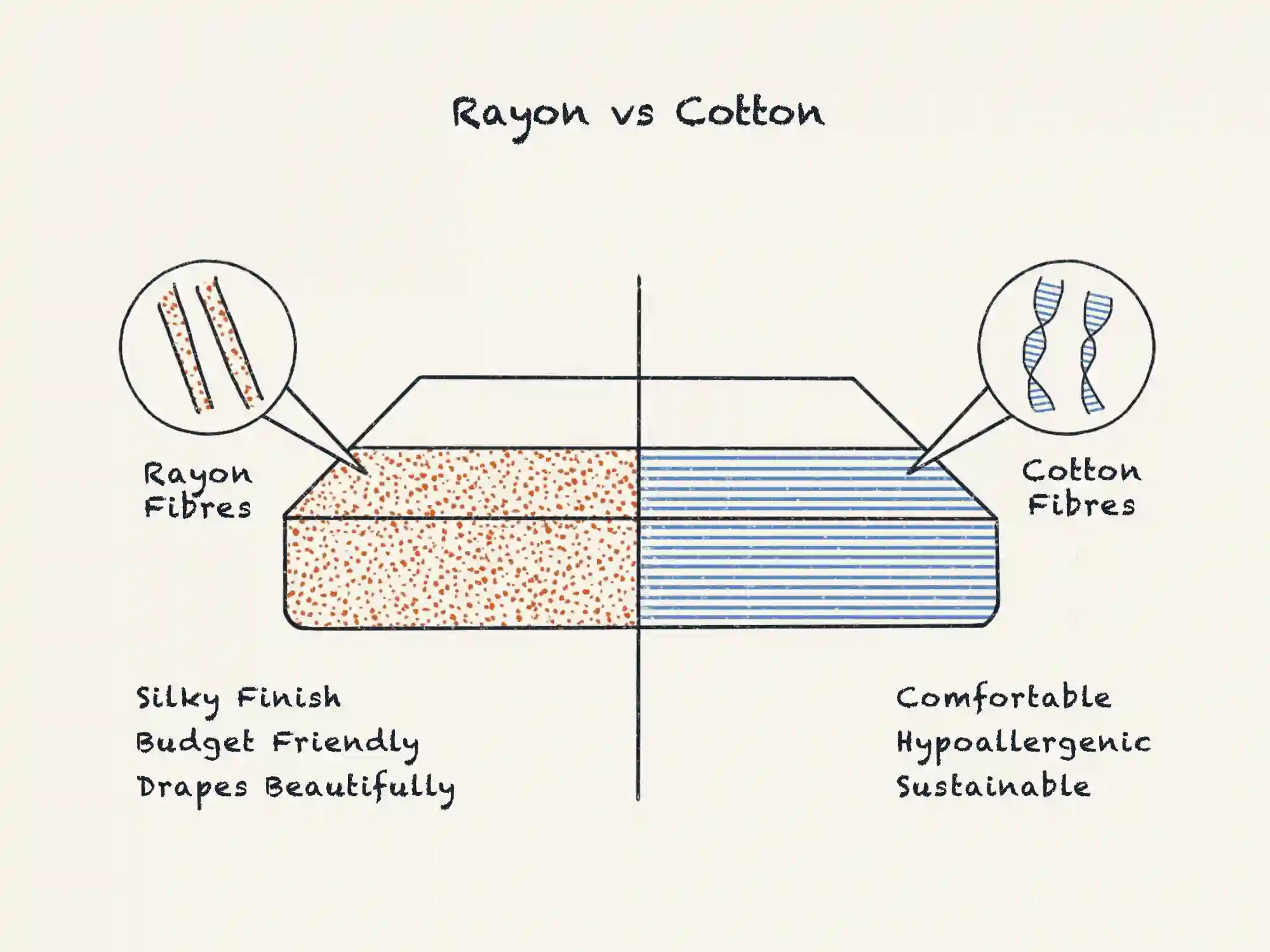Sleep Health
Published January 31, 2023
13 minRayon vs Cotton: What is the Difference
Every fabric is made differently, each possessing different characteristics. For example, wool comes from animals, silk from insects, and cotton from plants. Consequent to their origins, every fabric

Table of contents
Rayon vs Cotton: What is the Difference What Are Rayon Sheets Pros and Cons of Rayon Types of Rayon What Are Cotton Sheets Pros and Cons of Cotton Types of Cotton What Is the Difference Between Rayon and CottonConclusion Frequently Asked Questions
Every fabric is made differently, each possessing different characteristics. For example, wool comes from animals, silk from insects, and cotton from plants. Consequent to their origins, every fabric has different attributes and needs to be treated differently.One such varying comparison is rayon vs cotton. Though both fabrics are widespread and are used in the textile industry, one is semi-synthetic, and the other is resourced naturally. Besides the different resources, keep reading to know what else is different.
Rayon vs Cotton: What is the Difference
| Parameter | Rayon | Cotton |
|---|---|---|
| Origin | Wood pulp | Cotton plant |
| Strength | Becomes weak when wet | Have a strong tensile strength |
| Durability | With proper care, it can be in good shape and last many years | Lasts many years, but pills overtime |
| Softness | Smooth and silky | Soft and fluffy |
| Elasticity | unless blended with spandex its not elastic | When made into a knit fabric it's somewhat elastic |
| Absorbency | More absorbent than cotton | Highly absorbent |
| Pilling | Does not pill over time | Pills overtime |
| Wrinkling | Does not wrinkle easily | Wrinkles easily |
| Sustainability | Not as sustainable as completely natural fabrics, but is more eco-friendly than most synthetic fabrics | Renewable plant resources but production methods are environmentally unsustainable |
| Care | Handle it gently, often requires dry cleaning | Normal care, machine washable, though dryer use is not recommended |
| Cost | Cheaper than real silk, but more expensive than most synthetic fabrics | Compared to synthetic fabrics it is expensive |
| Uses | Everything from apparel and bedsheets to tire cord | Everything, from clothing, curtains, beddings to medical bandages |
What Are Rayon Sheets
Before getting on with rayon sheets, first, know what is rayon. Rayon is a semi-synthetic fiber manufactured from regenerated cellulosic fiber derived from wood pulp,from eucalyptus trees, bamboo, soy, cotton, etc. It was developed as the substitute for silk in the late 19th century and was the first man-made fiber. Sheets made from rayon fabric are rayon sheets . When comparing cotton vs rayon, though rayon is not as sustainable as natural fabrics, it is more eco-friendly than most synthetic fabrics and has many properties similar to cotton. Furthermore, rayon and cotton sheets are often preferred by some people as bedding due to its smooth and silky texture and its high absorbent and breathable quality.Pros and Cons of Rayon
Here are some advantages of rayon, as well as disadvantages.Pros
- Breathable: Rayon has high moisture-wicking properties, making it feel softer, more comfortable, and lightweight against the skin than most synthetic materials.
- Luxurious Appearance: Being the substitute for silk, rayon is silky, smooth and drapable.
- Versatile: Rayon can hold its dye very well and are available in various prints; in addition to that, it can blend well with other fabrics.
- Wrinkle resistant: It is wrinkle resistant.
- Cost: As a silk substitute, the manufacturing cost is much cheaper.
Cons
- Lightweight: Since the fabric is lightweight, it can get damaged easily if not handled with care.
- Shrinks easily: Rayon can shrink easily when wet and often requires a dry clean or hand wash.
- Durability: It is not a durable fabric, and gentle care when washing and ironing to ensure it doesn't lose its shape.
- Harmful production process: Although rayon uses fewer chemicals than a fully synthetic fabric, it is still manufactured with a complex chemical process making it environmentally unfriendly.
- May cause an allergic reaction: Because of all the chemicals used in manufacturing, people with sensitive skin may experience an allergic reaction
Types of Rayon
There are mainly three types of rayon that vary in the manufacturing process, fiber properties, and applications.Viscose
Viscose rayon is the first and the most common variant of the rayon fabric that was developed in 1884 as a cheaper alternative to silk. The manufacturing process involves 7 clear steps that include extracting and dissolving the wood into a pulp solution, which is then washed, cleaned, and bleached. This silk alternative remains popular and is used in clothing, household items, etc.Modal
Modal is the version of rayon that represents a significant evolution in the history of this fabric. It was first developed in 1951 in Japan, and in more than one way, modal rayon is nearly identical to viscose rayon. The modal rayon uses hardwood cellulose such as birch and oak. The production requirements are similar to viscose rayon, and the steps involve spinning reconstituted beech trees into cellulose fibers that are then woven into fabric. They are often blended with spandex to create a stretchy and comfy material, commonly used for making sportswear, underwear, T-shirts, and bed sheets.Lyocell
Lyocell is another variation of rayon fabric used as a silk or cotton substitute. It was initially developed in 1972 by American Enka; it became popular in the 20th century and is still relatively popular. And unlike the other two, lyocell rayon manufacturing involves directly dissolving the pulp and spinning it into cellulose fibers. They are commonly used for making denim, dress shirts, underwear, towels, etc.What Are Cotton Sheets
Compared with synthetic rayon vs cotton, cotton fabric is resourced naturally from the cellulose that grows in a protective case around the seeds of the cotton plant. And unlike silk, manufactured only in Asia, cotton is now produced worldwide.The history of cotton goes way back and can be traced to domestication, where it has been used as a fiber at least since 3000 B.C. by Indians and Americans. However, no one accurately knows where cotton primarily originated from.Even so, this fluffy and soft gift of nature can be modified into several varieties of fabrics. It ranges from lightweight voiles and laces to heavy sailcloths and thick-piled velvets, suitable for various wearable articles of clothing, home furnishings, and industrial uses. However, between cotton vs rayon, cotton sheets are the top choice for people prioritizing cool, comfortable, and restful sleep.Pros and Cons of Cotton
Following are the pros and cons of cotton fabric.Pros
- Fluffy and comfortable: Being resourced from fibrous seed and the extracted quality of cotton staples, it can provide highly soft fabric depending on the thread count.
- Versatile: It is informed that natural fibers such as cotton, silk, and wool take dye much better than synthetics and can be used in making everything from t-shirts and bedsheets to medical bandages.
- Breathable: The porous fibers and loose weaving make the fabric breathable.
- Easy to maintain: Cotton fabrics are easy to care for, which means it does not require extra care like synthetic materials when washing and ironing.
- Durable: Cotton fabrics are durable .
Cons
- Wrinkles: The cotton fabric wrinkles easily.
- Harmful to the environment: Although cotton is sustainable when compared to synthetic fabrics, its cultivation causes severe soil erosion and degradation remaining constant for the past 70 years, cotton harvest has depleted and degraded the soil in many areas.
- Less yield: Compared to conventional cotton, organic cotton has less yield, which means modified seeds use chemical fertilizers to promote plant growth.











